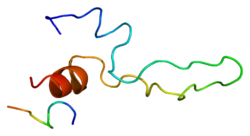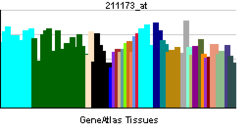- Cholecystokinin A receptor
-
Cholecystokinin A receptor, N-terminal domain 
molecular complex of cholecystokinin-8 and n-terminus of the cholecystokinin a receptor by nmr spectroscopy Identifiers Symbol CholecysA-Rec_N Pfam PF09193 InterPro IPR015276 SCOP 1d6g Available protein structures: Pfam structures PDB RCSB PDB; PDBe PDBsum structure summary The Cholecystokinin A receptor is a human protein, also known as CCKAR or CCK1, with CCK1 now being the IUPHAR-recommended name.
This gene encodes a G-protein coupled receptor that binds non-sulfated members of the cholecystokinin (CCK) family of peptide hormones. This receptor is a major physiologic mediator of pancreatic enzyme secretion and smooth muscle contraction of the gallbladder and stomach. In the central and peripheral nervous system this receptor regulates satiety and the release of beta-endorphin and dopamine.[1]
The extracellular, N-terminal, domain of this protein adopts a tertiary structure consisting of a few helical turns and a disulfide-cross linked loop. It is required for interaction of the cholecystokinin A receptor with its corresponding hormonal ligand.[2]
Contents
Selective Ligands
Agonists
- Cholecystokinin
- CCK-4
- SR-146,131
- A-71623 - modified tetrapeptide, potent and selective CCKA agonist, IC50 3.7nM, 1200x selectivity over CCKB, CAS# 130408-77-4
Antagonists
- Proglumide
- Lorglumide
- Devazepide
- Dexloxiglumide
- Asperlicin
- SR-27897
- IQM-95333
- JNJ-17156516
See also
References
- ^ "Entrez Gene: CCKAR cholecystokinin A receptor". http://www.ncbi.nlm.nih.gov/sites/entrez?Db=gene&Cmd=ShowDetailView&TermToSearch=886.
- ^ Pellegrini M, Mierke DF (November 1999). "Molecular complex of cholecystokinin-8 and N-terminus of the cholecystokinin A receptor by NMR spectroscopy". Biochemistry 38 (45): 14775–83. doi:10.1021/bi991272l. PMID 10555959.
External links
- "Cholecystokinin Receptors: CCK1". IUPHAR Database of Receptors and Ion Channels. International Union of Basic and Clinical Pharmacology. http://www.iuphar-db.org/GPCR/ReceptorDisplayForward?receptorID=2247.
Further reading
- Varga G, Bálint A, Burghardt B, D'Amato M (2004). "Involvement of endogenous CCK and CCK1 receptors in colonic motor function.". Br. J. Pharmacol. 141 (8): 1275–84. doi:10.1038/sj.bjp.0705769. PMC 1574909. PMID 15100163. http://www.pubmedcentral.nih.gov/articlerender.fcgi?tool=pmcentrez&artid=1574909.
- Miller LJ, Holicky EL, Ulrich CD, Wieben ED (1995). "Abnormal processing of the human cholecystokinin receptor gene in association with gallstones and obesity.". Gastroenterology 109 (4): 1375–80. doi:10.1016/0016-5085(95)90601-0. PMID 7557108.
- Huppi K, Siwarski D, Pisegna JR, Wank S (1995). "Chromosomal localization of the gastric and brain receptors for cholecystokinin (CCKAR and CCKBR) in human and mouse.". Genomics 25 (3): 727–9. doi:10.1016/0888-7543(95)80018-H. PMID 7759110.
- de Weerth A, Pisegna JR, Huppi K, Wank SA (1993). "Molecular cloning, functional expression and chromosomal localization of the human cholecystokinin type A receptor.". Biochem. Biophys. Res. Commun. 194 (2): 811–8. doi:10.1006/bbrc.1993.1894. PMID 8343165.
- Ulrich CD, Ferber I, Holicky E, et al. (1993). "Molecular cloning and functional expression of the human gallbladder cholecystokinin A receptor.". Biochem. Biophys. Res. Commun. 193 (1): 204–11. doi:10.1006/bbrc.1993.1610. PMID 8503909.
- Kennedy K, Gigoux V, Escrieut C, et al. (1997). "Identification of two amino acids of the human cholecystokinin-A receptor that interact with the N-terminal moiety of cholecystokinin.". J. Biol. Chem. 272 (5): 2920–6. doi:10.1074/jbc.272.5.2920. PMID 9006937.
- Inoue H, Iannotti CA, Welling CM, et al. (1997). "Human cholecystokinin type A receptor gene: cytogenetic localization, physical mapping, and identification of two missense variants in patients with obesity and non-insulin-dependent diabetes mellitus (NIDDM).". Genomics 42 (2): 331–5. doi:10.1006/geno.1997.4749. PMID 9192855.
- Gigoux V, Escrieut C, Silvente-Poirot S, et al. (1998). "Met-195 of the cholecystokinin-A receptor interacts with the sulfated tyrosine of cholecystokinin and is crucial for receptor transition to high affinity state.". J. Biol. Chem. 273 (23): 14380–6. doi:10.1074/jbc.273.23.14380. PMID 9603948.
- Funakoshi A, Fukamizu Y, Miyasaka K (2000). "Mechanism of cholecystokinin-A- receptor antagonist on human pancreatic exocrine secretion. Localization of CCK-A receptor in the human duodenum.". Digestion 60 Suppl 1: 75–80. PMID 10026437.
- Gigoux V, Escrieut C, Fehrentz JA, et al. (1999). "Arginine 336 and asparagine 333 of the human cholecystokinin-A receptor binding site interact with the penultimate aspartic acid and the C-terminal amide of cholecystokinin.". J. Biol. Chem. 274 (29): 20457–64. doi:10.1074/jbc.274.29.20457. PMID 10400673.
- Gigoux V, Maigret B, Escrieut C, et al. (2000). "Arginine 197 of the cholecystokinin-A receptor binding site interacts with the sulfate of the peptide agonist cholecystokinin.". Protein Sci. 8 (11): 2347–54. doi:10.1110/ps.8.11.2347. PMC 2144185. PMID 10595537. http://www.pubmedcentral.nih.gov/articlerender.fcgi?tool=pmcentrez&artid=2144185.
- Funakoshi A, Miyasaka K, Matsumoto H, et al. (2000). "Gene structure of human cholecystokinin (CCK) type-A receptor: body fat content is related to CCK type-A receptor gene promoter polymorphism.". FEBS Lett. 466 (2–3): 264–6. doi:10.1016/S0014-5793(00)01080-2. PMID 10682840.
- Tachikawa H, Harada S, Kawanishi Y, et al. (2000). "Novel polymorphisms of the human cholecystokinin A receptor gene: an association analysis with schizophrenia". Am. J. Med. Genet. 96 (2): 141–5. doi:10.1002/(SICI)1096-8628(20000403)96:2<141::AID-AJMG3>3.0.CO;2-R. PMID 10893485.
- Giragossian C, Mierke DF (2001). "Intermolecular interactions between cholecystokinin-8 and the third extracellular loop of the cholecystokinin A receptor". Biochemistry 40 (13): 3804–9. doi:10.1021/bi002659n. PMID 11300760.
- Schmitz F, Schrader H, Otte J, et al. (2002). "Identification of CCK-B/gastrin receptor splice variants in human peripheral blood mononuclear cells". Regul. Pept. 101 (1–3): 25–33. doi:10.1016/S0167-0115(01)00281-6. PMID 11495676.
- Tachikawa H, Harada S, Kawanishi Y, et al. (2002). "Linked polymorphisms (-333G>T and -286A>G) in the promoter region of the CCK-A receptor gene may be associated with schizophrenia". Psychiatry research 103 (2–3): 147–55. doi:10.1016/S0165-1781(01)00276-1. PMID 11549403.
- Schmitz F, Göke MN, Otte JM, et al. (2002). "Cellular expression of CCK-A and CCK-B/gastrin receptors in human gastric mucosa". Regul. Pept. 102 (2–3): 101–10. doi:10.1016/S0167-0115(01)00307-X. PMID 11730982.
- Okubo T, Harada S, Higuchi S, Matsushita S (2003). "Investigation of quantitative trait loci in the CCKAR gene with susceptibility to alcoholism". Alcohol. Clin. Exp. Res. 26 (8 Suppl): 2S–5S. doi:10.1097/01.ALC.0000026826.96191.FB. PMID 12198366.
- Takata Y, Takeda S, Kawanami T, et al. (2003). "Promoter analysis of human cholecystokinin type-A receptor gene". J. Gastroenterol. 37 (10): 815–20. doi:10.1007/s005350200135. PMID 12424565.
This article incorporates text from the United States National Library of Medicine, which is in the public domain.
Cell surface receptor: G protein-coupled receptors Class A:
Rhodopsin likeOtherMetabolites and
signaling moleculesOtherBile acid · Cannabinoid (CB1, CB2, GPR (18, 55, 119)) · EBI2 · Estrogen · Free fatty acid (1, 2, 3, 4) · Lactate · Lysophosphatidic acid (1, 2, 3, 4, 5, 6) · Lysophospholipid (1, 2, 3, 4, 5, 6, 7, 8) · Niacin (1, 2) · Oxoglutarate · PAF · Sphingosine-1-phosphate (1, 2, 3, 4, 5) · SuccinatePeptideOtherAnaphylatoxin (C3a, C5a) · Angiotensin (1, 2) · Apelin · Bombesin (BRS3, GRPR, NMBR) · Bradykinin (B1, B2) · Chemokine · Cholecystokinin (A, B) · Endothelin (A, B) · Formyl peptide (1, 2, 3) · FSH · Galanin (1, 2, 3) · GHB receptor · Gonadotropin-releasing hormone (1, 2) · Ghrelin · Kisspeptin · Luteinizing hormone/choriogonadotropin · MAS (1, 1L, D, E, F, G, X1, X2, X3, X4) · Melanocortin (1, 2, 3, 4, 5) · MCHR (1, 2) · Motilin · Opioid (Delta, Kappa, Mu, Nociceptin & Zeta, but not Sigma) · Orexin (1, 2) · Oxytocin · Prokineticin (1, 2) · Prolactin-releasing peptide · Relaxin (1, 2, 3, 4) · Somatostatin (1, 2, 3, 4, 5) · Tachykinin (1, 2, 3) · Thyrotropin · Thyrotropin-releasing hormone · Urotensin-II · Vasopressin (1A, 1B, 2)MiscellaneousGPR (1, 3, 4, 6, 12, 15, 17, 18, 19, 20, 21, 22, 23, 25, 26, 27, 31, 32, 33, 34, 35, 37, 39, 42, 44, 45, 50, 52, 55, 61, 62, 63, 65, 68, 75, 77, 78, 81, 82, 83, 84, 85, 87, 88, 92, 101, 103, 109A, 109B, 119, 120, 132, 135, 137B, 139, 141, 142, 146, 148, 149, 150, 151, 152, 153, 160, 161, 162, 171, 173, 174, 176, 177, 182, 183)OtherClass B: Secretin like OtherBrain-specific angiogenesis inhibitor (1, 2, 3) · Cadherin (1, 2, 3) · Calcitonin · CALCRL · CD97 · Corticotropin-releasing hormone (1, 2) · EMR (1, 2, 3) · Glucagon (GR, GIPR, GLP1R, GLP2R) · Growth hormone releasing hormone · PACAPR1 · GPR · Latrophilin (1, 2, 3, ELTD1) · Methuselah-like proteins · Parathyroid hormone (1, 2) · Secretin · Vasoactive intestinal peptide (1, 2)Class C: Metabotropic
glutamate / pheromoneOtherClass F:
Frizzled / SmoothenedFrizzledSmoothenedB trdu: iter (nrpl/grfl/cytl/horl), csrc (lgic, enzr, gprc, igsr, intg, nrpr/grfr/cytr), itra (adap, gbpr, mapk), calc, lipd; path (hedp, wntp, tgfp+mapp, notp, jakp, fsap, hipp, tlrp) Neuropeptide receptors G protein-coupled receptor OtherOther neuropeptide receptorsAngiotensin · Bradykinin (B1, B2) / Tachykinin (TACR1) · Calcitonin gene-related peptide · Galanin · GPCR neuropeptide (B/W, FF, S, Y) · NeurotensinType I cytokine receptor Enzyme-linked receptor Other B trdu: iter (nrpl/grfl/cytl/horl), csrc (lgic, enzr, gprc, igsr, intg, nrpr/grfr/cytr), itra (adap, gbpr, mapk), calc, lipd; path (hedp, wntp, tgfp+mapp, notp, jakp, fsap, hipp, tlrp) Neuropeptidergics Cholecystokinin CCKAAgonists: Cholecystokinin • CCK-4
Antagonists: Asperlicin • Proglumide • Lorglumide • Devazepide • DexloxiglumideCCKBCRH Agonists: Corticotropin releasing hormoneGalanin Ghrelin MCH Agonists: Melanin concentrating hormone
Antagonists: ATC-0175 • GW-803,430 • NGD-4715 • SNAP-7941 • SNAP-94847Melanocortin Agonists: alpha-MSH • Afamelanotide • Bremelanotide • Melanotan II
Antagonists: Agouti signalling peptideNeuropeptide S Neuropeptide Y Neurotensin Opioid see Template:OpioidsOrexin Oxytocin Agonists: Carbetocin • Demoxytocin • Oxytocin • WAY-267,464
Antagonists: Atosiban • Epelsiban • L-371,257 • L-368,899Tachykinin Agonists: Substance P
Antagonists: Aprepitant • Befetupitant • Casopitant • CI-1021 • CP-96,345 • CP-99,994 • CP-122,721 • Dapitant • Ezlopitant • FK-888 • Fosaprepitant • GR-203,040 • GW-597,599 • HSP-117 • L-733,060 • L-741,671 • L-743,310 • L-758,298 • Lanepitant • LY-306,740 • Maropitant • Netupitant • NKP-608 • Nolpitantium • Orvepitant • RP-67,580 • SDZ NKT 343 • Vestipitant • VofopitantVasopressin Agonists: Desmopressin • Felypressin • Ornipressin • Terlipressin • Vasopressin
Antagonists: Conivaptan • Demeclocycline • RelcovaptanAgonists: Felypressin • Ornipressin • Terlipressin • Vasopressin
Antagonists: Demeclocycline • NelivaptanAgonists: Desmopressin • Ornipressin • Vasopressin
Antagonists: Conivaptan • Demeclocycline • Lixivaptan • Mozavaptan • Satavaptan • Tolvaptan
This article includes text from the public domain Pfam and InterPro IPR015276 - Human proteins
- Transmembrane receptor stubs
- G protein coupled receptors
- Protein domains
Wikimedia Foundation. 2010.



